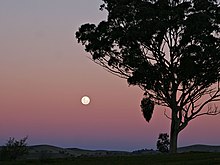Belt of Venus
This article needs additional citations for verification. (September 2015) |


The Belt of Venus (also called Venus's Girdle, the antitwilight arch, or antitwilight[1]) is an atmospheric phenomenon visible shortly before sunrise or after sunset, during civil twilight. It is a pinkish glow that surrounds the observer, extending roughly 10–20° above the horizon. It appears opposite to the afterglow, which it also reflects.
In a way, the Belt of Venus is actually alpenglow visible near the horizon during twilight, above the antisolar point. Like alpenglow, the backscatter of reddened sunlight also creates the Belt of Venus. Though unlike alpenglow, the sunlight scattered by fine particulates that cause the rosy arch of the Belt shines high in the atmosphere and lasts for a while after sunset or before sunrise.[2]
As twilight progresses, the arch is separated from the horizon by the dark band of Earth's shadow, or "twilight wedge". The pinkish glow is due to the Rayleigh scattering of light from the rising or setting Sun, which is then backscattered by particulates. A similar effect can be seen on a "blood moon" during a total lunar eclipse. The zodiacal light and gegenschein, which are caused by the diffuse reflection of sunlight from interplanetary dust in the Solar System, are also similar phenomena.
The Belt of Venus can be observed as having a vivider pink color during the winter months, as opposed to the summer months, when it appears faded and dim above the yellowish-orange band near the horizon.[citation needed]
The name of the phenomenon alludes to the cestus, a girdle or breast-band, of the Ancient Greek goddess Aphrodite, customarily equated with the Roman goddess Venus. Since the greatest elongation (angular separation between the Sun and a Solar System body) of Venus is only 45–48°, the inferior planet never appears in the opposite of the Sun's direction (180° difference in ecliptic longitude) from Earth and is thus never located in the Belt of Venus.
See also
References
- ^ "Definition of ANTITWILIGHT". www.merriam-webster.com.
- ^ Powell, Jonathan (2018). "Atmospheric Factors and Features". The Patrick Moore Practical Astronomy Series. Cham: Springer International Publishing. pp. 105–130. doi:10.1007/978-3-319-97701-0_8. ISBN 978-3-319-97700-3. ISSN 1431-9756.
- Cowley, Les. "Belt of Venus". Atmospheric Optics. Les Cowley. Retrieved 2018-08-01.
- Naylor, John (2002). Out of the blue : a 24-hour skywatcher's guide. Cambridge: Cambridge University Press. p. 72. ISBN 0-521-80925-8.
External links
- NASA Astronomy Picture of the Day: The Belt of Venus over the Valley of the Moon (23 July 2006)
- NASA Astronomy Picture of the Day: The Belt of Venus Over Mercedes, Argentina (scroll to right of image for best view) (7 February 2012)
- Shadow of Earth, Belt of Venus as seen over Half Dome, Yosemite National Park, displayed in an interactive panorama. Scroll to the very bottom of the post to view, after all other Yosemite panoramas.

